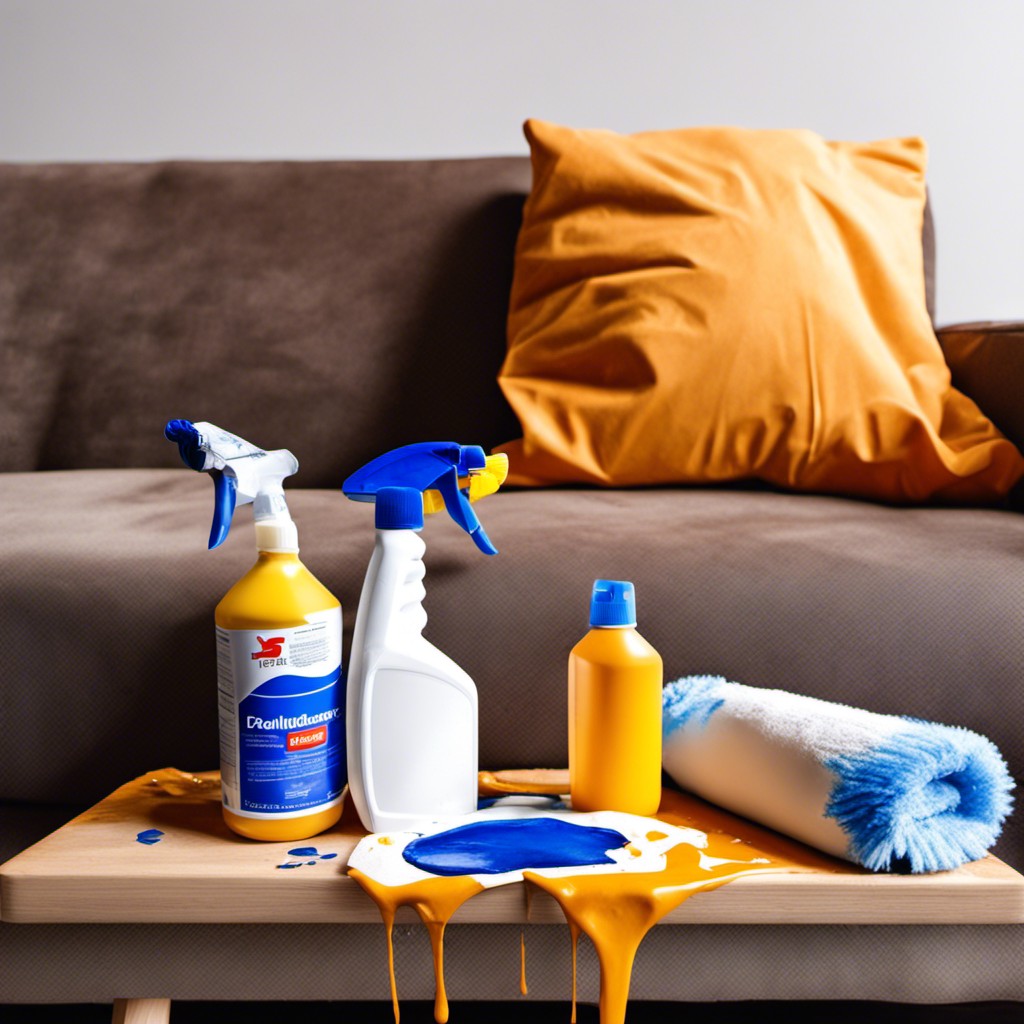Last updated on
Dive into this article because it offers simple, effective techniques for removing stubborn paint stains from your cherished couch.
Removing paint from your couch can seem like a daunting task, but don’t fret. This article will guide you through a simple, step-by-step process to tackle this common household mishap. Whether it’s a fresh spill or dried-on paint, we’ve got you covered.
We’ll discuss safe, effective methods and materials that you can use to restore your couch to its former glory. Stay tuned to learn about everything from using a homemade solution to employing commercial paint removers, ensuring you have all the information you need to make the best decision for your situation.
Key takeaways:
- Gather necessary materials for paint removal
- Use appropriate tools for the removal process
- Test solvents on a hidden area of the couch first
- Follow specific techniques for water-based and oil-based paint stains
- Thoroughly rinse the treated area and properly air-dry the upholstery
Table of Contents
Required Materials for Paint Removal

From specialized cleaners to common household items, several materials are critical for a successful paint removal. Gather the following items:
- Commercial paint removal products: These specialized solvents, like Goof Off or others, are exceptionally powerful, designed to lift away paint without damaging the fabric underneath.
- Rubbing alcohol: A versatile home remedial product that can aid in loosening water-based paint stains.
- A clean white cloth or sponge: These will be the primary methods of application for your paint removal product. White is preferred to discredit dye transfer.
- A hairdryer or fan: Useful for controlled drying of the treated area post-cleaning to prevent further damage or spreading.
- Dish soap and water: A combination of the two can serve as a gentle, but effective solution for cleaning up softer stains.
- Cotton swabs: Ideal for spot treatment of smaller, persistent paint spots that need targeted application.
Remember, getting your materials in order beforehand can directly impact the success of your paint removal efforts.
Appropriate Equipment/Tools for Paint Removal From Couch

Having the right tools on hand can streamline the paint removal process, ensuring a clean and damage-free result. These tools include:
- Rubber Gloves: Protection for your hands, crucial when dealing with chemicals.
- Spoon or Dull Knife: Perfect for scraping off dried paint without damaging the upholstery.
- Soft Cloth or Sponge: To blot the paint stain and apply solvents.
- Mild Soap or Upholstery Cleaner: Ideal for cleaning the stained area after paint removal.
- Commercial Solvents: Useful for dissolving stubborn paint spots. Make sure to choose one suitable for the material of your couch.
- Spray Bottle: Essential for applying the cleaning solution evenly.
Remember, no matter the tool, always use them carefully to prevent further damage to your prized couch.
Testing Solvent Safety for Paint Removal
Before you dive head-first into the paint removal process, choosing a safe solvent is crucial. It’s advisable to test the products on an inconspicuous area of your upholstery, like the couch’s underside or backside. This will help identify if the solvent causes color fading or fabric damage.
Two common types of solvents are water-based, such as rubbing alcohol and hairspray, and oil-based, like turpentine and nail polish remover. They’re excellent for dissolving water and oil-based paint stains, respectively. However, their efficiency varies remarkably based on the fabric type.
For synthetic fabrics like polyester, apply a small amount of the solvent and let it sit for five minutes. Rinse the spot thoroughly with cold water and observe if there’s any discoloration or change in texture. For natural fabrics, such as cotton or linen, soak a white cloth in the solvent and dab the hidden area. Note the immediate effects before proceeding.
Remember, always put on your gloves when handling these solvents to avoid skin irritation. Safety must be your primary focus in this process, so ensure your work area is well-ventilated because some solvents release fumes that might be harmful if inhaled in large quantities.
Removing Water-Based Paint Stains From Furniture
First, dampen a soft cloth or sponge in warm water, gently blotting the dried water-based paint stain. Be careful not to soak the area, as excess water can lead to further problems.
Next, take a solution of mild liquid dish soap and warm water, building up a good lather. Apply this to the stained upholstery with a soft brush. Application should be kept away from the surrounding fabric to avoid unnecessary cleaning.
The key is to use circular motions to lift the dried paint particles from the fibers of the fabric without causing them to spread further. Small amounts at a time, continuing the process until the paint begins to lift off the fabric, will yield rewarding results.
Remember, patience pays off. Resist the temptation to scrub too hard or use sharp objects to scrape the paint off as this could damage the fabric, and always perform a patch test before applying any solution to ensure it won’t cause more harm than good.
Creating and Applying a Cleaning Solution
Start the process by combining one tablespoon of dish soap with two cups of cold water. This mixture works effectively on water-based paints and can assure safe application to various upholstery materials. Stir it until the soap is fully dissolved, it should yield a bubbly solution.
When applying, the aim is not to drench the fabric. Instead, dip a clean cloth into the solution and dab it onto the paint stain. Let the solution penetrate the stain by allowing it to sit for about five minutes. Following this, blot the treated area with a non-soapy, damp cloth. Remember, aggressive rubbing may work the stain deeper into fibers, so blotting is recommended. Repeat these steps as necessary until the stain lightens.
Removing Oil-Based Paint Stains From Couch Upholstery
Using a plastic knife, scrape off any dried oil-based paint without damaging the fabric. For the residual stain, turn to products such as WD-40 or hair spray. Apply your chosen solvent lightly onto a cloth and gently dab it onto the blemish. Be cautious not to rub or scratch.
Step aside for ten minutes and let the solution do its job. Following this, take a separate, clean cloth and gently remove the solvent from the fabric. For persistent stains, repeat the process.
Remember, always test the solvent on a small, unseen part of the couch first, as different fabrics react differently to solvents.
Effective Rinsing Techniques After Stain Treatment
After treating the stain, it’s crucial to thoroughly rinse the affected area to remove residual cleaning solution. Leaving it behind can cause discolouration or fabric damage.
Here are the key points:
- Use a clean, damp cloth: This aids in flushing out the remaining solvent. Always remember to blot, not rub, to avoid spreading the stain or damaging the couch fabric.
- Apply distilled water: Ordinary tap water could contain minerals that can leave water mark on the couch. Distilled water works best in preventing these unsightly spots.
- Rinse multiple times: Repeating the process can ensure no solvent residue is left behind. Each time, use a fresh side of the cloth for best results.
- Pat dry: Every rinse round should be followed by patting the area dry with a clean dry towel. This helps to prevent over-saturation of the fabric, which may lead to water damage like mold or mildew.
- Be patient: Diligence and patience during rinsing will ensure the integrity of your couch fabric and ensure the stain is fully removed.
Proper Air-Drying Methods for Upholstery
For the final step in the process, it’s essential to let your now clean and stain-free furniture breathe. Placing it in a well-ventilated area is a good start. Avoid putting it in direct sunlight or in front of heaters to prevent discoloration or potential fabric warping.
A ceiling fan or a freestanding fan can aid in speeding up the drying process. The gentle air movement helps to evaporate any lingering moisture. Regularly inspect the upholstery to keep track of how it’s drying.
Using a dry towel to blot the surface can also assist in removing excess moisture. But remember to be gentle, heavy rubbing can damage the fabric.
Consider professional cleaning services if your upholstery is expensive or made of delicate materials like silk or vintage fabric. This can help maintain the life and quality of your furniture.
By adhering to these guidelines, you’re taking necessary care to ensure your couch is free of unwanted paint splatters and is adequately dried to prevent any moisture damage.
FAQ
How do you get dried paint off a fabric couch?
To remove dried paint from a fabric couch, apply a few drops of solvent such as paint thinner, dry cleaning solvent, or turpentine on a microfiber cloth and gently blot the stain from the outside edge, ensuring to move to clean areas of the cloth as the paint transfers.
How do you get paint out of couch?
To get paint out of a couch, dampen a sponge with water and wipe stains from the outside to the center, then if the stain persists, use a sponge dampened with alcohol and blot the stain, changing the sponge as needed, then finally apply upholstery/rug shampoo as directed on its container.
What removes paint from fabric?
Alcohol-based items, such as rubbing alcohol, hand sanitizer, aerosol hair spray, or acetone nail polish remover, can effectively remove paint from fabric.
How do you remove paint without damaging furniture?
To remove paint from furniture without causing damage, start by using a manual hand sander or power sander with coarse 80-grit sandpaper, apply enough pressure to remove the paint without damaging the wood, then move to medium 150-grit abrasive, and finish with fine 220-grit, making sure to brush away the dust from the surface each time you change the paper.
What are the necessary safety measures to follow while removing paint from a fabric couch?
While removing paint from a fabric couch, use minimal water to avoid soaking the structure, wear gloves and a mask, and ensure that the area is well-ventilated to mitigate chemical fumes.
Can professional upholstery cleaning services effectively remove paint stains?
Yes, professional upholstery cleaning services can effectively remove paint stains using specialized cleaning solutions and techniques.
Is it possible to restore the original appearance of a couch after a paint spill?
Yes, it’s possible to restore the original appearance of a couch after a paint spill using specific cleaning techniques and materials.





